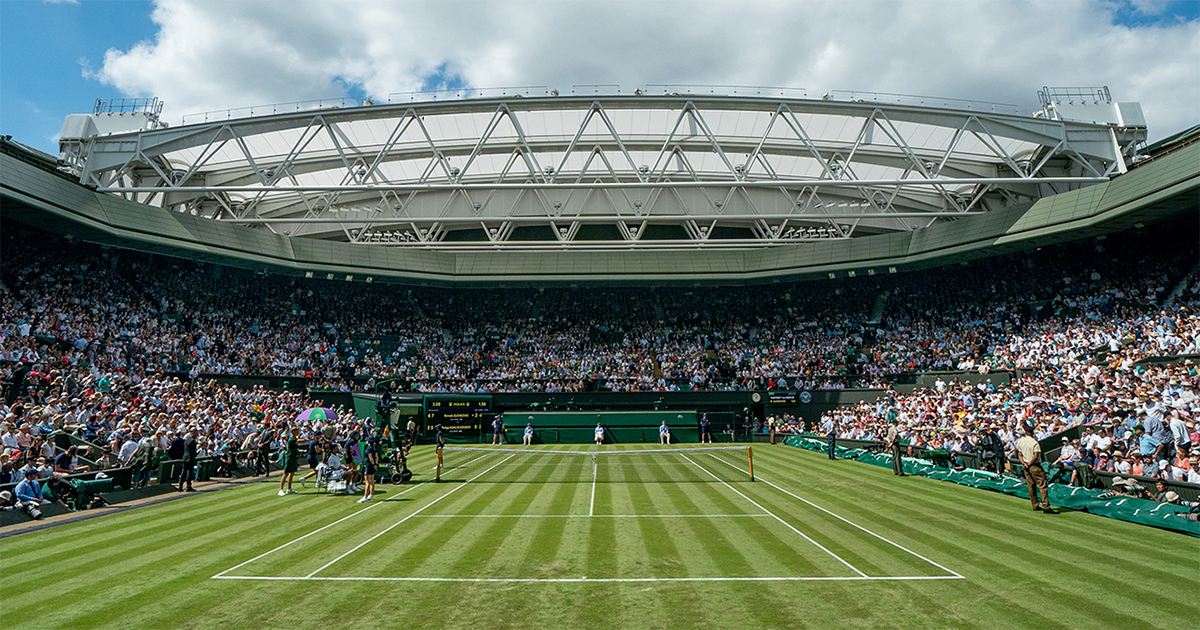
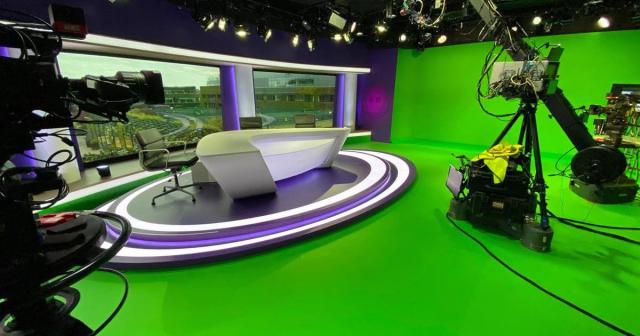
As the oldest tennis tournament in the world, The Championships at Wimbledon have been held by the All-England Lawn Tennis and Croquet Club (AELTC) since 1877 and are one of the four Grand Slam tournaments in professional tennis.
Sports and events graphics company MOOV gave an eye-catching new look to BBC Sport’s on-site studio at Wimbledon 2021, which also offered new ways of interacting with the audience and delivered enhanced storytelling during this year’s Championships (June 28 to July 11).
Instead of rebuilding the physical set, MOOV and BBC Sport decided to virtualize it to take advantage of the possibilities that virtual technology provides. MOOV partnered with Brainstorm to deliver the set and AR based on the company’s InfinitySet virtual studio application and integrated with Epic Games’ Unreal Engine and the Mo-Sys StarTracker camera tracking system.
What started as a discussion concept between BBC and MOOV before the cancellation of Wimbledon 2020 developed into a full-blown project as a result of a drive to maximize the available time ahead of the 2021 Championships, bringing the focus onto the virtual facilities and to rethink the way the coverage was managed and so provide better stories, data and graphics.
“This was a particularly challenging project, not only due to the time constraints, but also because of restrictions on people on-site as well as technical issues such as the requirements to re-purpose the studio for the daily highlights.”
— Nev Appleton
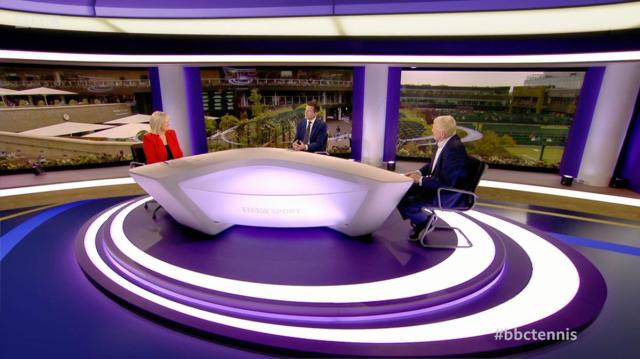
Built around a green screen studio, the Wimbledon studio virtualization effectively extended the space available far beyond its physical limits, providing new virtual spaces around the real desk, which in effect created a 360-degree studio. There were also new and alternative camera angles, plus more room to add infographics and Wimbledon branding. The added bonus was the flexibility to change, adapt and make adjustments on-demand with InfinitySet.
“We managed to create a virtual space that allowed for dynamic coverage of the tournament which combined real and virtual imagery in a way that significantly enhanced the story and audience engagement,” said Nev Appleton, Director and Co-Founder at MOOV.
“This was a particularly challenging project, not only due to the time constraints, but also because of restrictions on people on-site as well as technical issues such as the requirement to re-purpose the studio for the daily highlights show. But, despite the challenges, the really great results reinforced our commitment to use virtual technology for enhancing live events.”
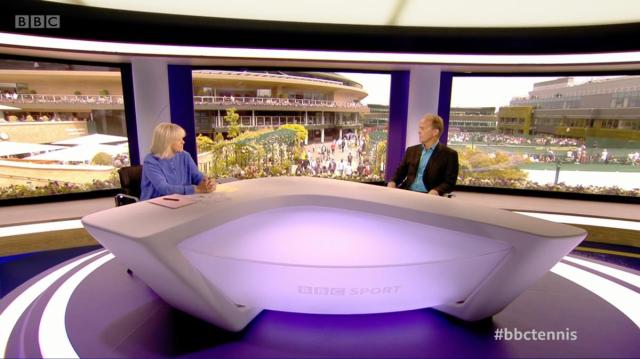
The project had to be produced in record time, as the set designs were available only at the end of April 2021. MOOV worked closely with BBC Sport as well as with a team of artists. As the studio had five cameras, including pedestals, jibs and PTZ to ensure the output quality required, each camera was equipped with a Brainstorm InfinitySet system with Unreal Engine. The final output combined the real set with a desk for the presenters and actual windows looking out to show the courts — integrated with the virtual world to enable graphics and AR information to be displayed on demand.
John Murphy, Creative Director, Motion at BBC Sport told Jake Bickerton at Broadcast Now, “This has been a hugely collaborative project between the BBC and MOOV — we required a studio that would be flexible and adaptable to allow us to create a unique Wimbledon experience for our viewers. We have worked alongside MOOV for several years now, so we had no hesitation in collaborating with them and relied on their expertise and knowledge to deliver a truly immersive and innovative virtual reality studio.”
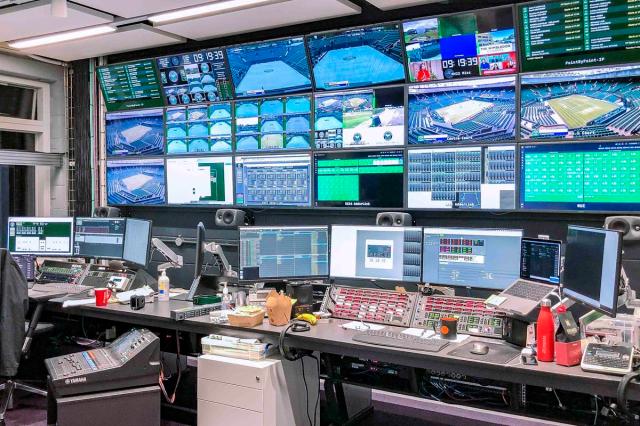
READ MORE: Behind-the-scenes: Wimbledon 2021 virtual studio (Broadcast Now)
David Alexander, Brainstorm’s Commercial Director, said: “Together with Paul Vanlint of Storm Broadcast, our reseller in the UK and Ireland, we’ve worked with MOOV on a number of projects — but what was done at Wimbledon 2021 was at another level altogether!
“MOOV has a really talented team with an in-depth knowledge of our products and how to get the most out of their feature sets and capabilities, whether it’s the InfinitySet or our Aston 3D motion graphics system, through to our Neuron, which integrates graphics and their management into NRCS systems. So, we were very pleased to work with the MOOV team on the BBC Sport project for such a prestigious and world renowned sporting event,” said Alexander.
Remote Audio Mixing for Officials and Production Teams
In another significant innovation at Wimbledon, the All-England Lawn Tennis and Croquet Club installed a fixed signal routing and communications network based on Riedel’s MediorNet real-time signal transport and processing technology, and Artist digital matrix intercom mainframe.

For the 2021 tournament, the MediorNet/Artist solution facilitated remote audio mixing to support communications between review officials and umpires, statisticians, safety, security, audio and production teams as well as video feeds to aid the audio team with press feed distribution and remote operation of all courts.
While the basic network remains in place year-round at AELTC, Riedel Managed Technology was brought in to supply the additional panels, nodes, and other gear necessary to support tournament play at 18 different courts over the 14 days of Wimbledon.
“Wimbledon is steeped in tradition, but we’re certainly not standing still. We’re always looking to stay on the edge of technology and apply the latest innovations to make the Championships the best they can possibly be,” said James Henry Breward, Audio and Communications Specialist, AELTC.
“We know we can count on Riedel equipment to provide reliable communications with fantastic sound quality when it really matters, such as when resolving debatable review calls. And with all of the additional equipment that comes in quickly for the Championships, we depend on Riedel’s Managed Technology division to help us meet our tight timeframes.”
The permanent Riedel installation at AELTC consists of an Artist-64 intercom node and a handful of 2300 SmartPanels to support year-round security and audio teams. In the run-up to the 2021 Wimbledon tournament, Riedel Managed Technology division expanded the fixed infrastructure with an array of additional Artist and MediorNet equipment, including MediorNet MicroN high-density media distribution network devices, around 120 intercom panels, and Bolero, offering coverage over much of the grounds.
“We’re always looking to stay on the edge of technology and apply the latest innovations to make the Championships the best they can possibly be.”
— James Henry Breward

With their ability to be deployed in unlimited configurations, the modular MicroNs came in handy particularly in the AELTC master control room, the nerve center for all audio signals, where the signals from the 18 courts, big screen production, and countless local mixes come together.
Additional MicroNs configured with the Riedel MultiViewer App were located in the Centre Court PA rack room. This enabled the production crew in master control to mix audio signals from up to 36 SDI broadcast and MADI feeds from Artist, house audio, OB comms 4-wires, and program feeds. Audio meters on the MicroN multi-viewers were customized to show each umpire’s mic on the left side and the signal sent to the courtside PA on the right, while the Under Monitor Display (UMD) shows the umpire microphone switch state.

